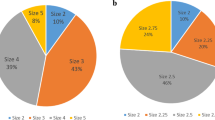Abstract
Introduction and hypothesis
The causes of recurrence of pelvic organ prolapse (POP) are sufficiently understood. However, few studies are available evaluating reoperation for recurrence of POP. This study evaluates the efficacy and safety of LeFort colpocleisis for recurrent POP.
Methods
We reviewed data from patients with recurrent POP who underwent LerFort colpocleisis at a center between March 2012 and April 2017. Quality of life was assessed using the Pelvic Floor Distress Inventory Questionnaire (PFDI-20) scores. The Patient Global Impression of Improvement scale (PGI-I) was used to assess self-perceived success and subjective measures of satisfaction. The Clavien-Dindo classification (CD) was used to assess the safety of the procedure. Chi-square and paired t-tests were used to compare the same patients before and after treatment in the follow-up.
Results
Twenty-six patients with recurrent POP after previous prolapse surgery underwent LeFort colpocleisis. Most of these patients had at least one comorbidity. The mean age (years) was 71.8 (7.3). The mean time to recurrent POP was 5.602 (3.643) years. There were no intraoperative bladder lesions or rectal lesions. At mean follow-up of 33.1 months, all patients had no recurrence (< stage 2), significant resolution of awareness of prolapse (P < 0.05), and significantly improved satisfaction on PGI-I after surgery. Minor complications were classified as CD II level in four cases (15.4%).
Conclusion
This study suggests that LeFort colpocleisis is feasible and safe for recurrent POP, especially in older women with comorbidities.
Similar content being viewed by others
References
Wilkins MF, Wu JM. Lifetime risk of surgery for stress urinary incontinence or pelvic organ prolapse. Minerva Ginecol. 2017;69(2):171–7.
Dallas KB, Rogo-Gupta L, Elliott CS. What impacts the all cause risk of reoperation after pelvic organ prolapse repair? A comparison of mesh and native tissue approaches in 110,329 women. J Urol. 2018;3(18):42415–9.
Jonsson Funk M, Visco AG, Weidner AC, Pate V, Wu JM. Long-term outcomes of vaginal mesh versus native tissue repair for anterior vaginal wall prolapse. Int Urogynecol J. 2013;24(8):1279–85.
Manodoro S, Frigerio M, Cola A, Spelzini F, Milani R. Risk factors for recurrence after hysterectomy plus native-tissue repair as primary treatment for genital prolapse. Int Urogynecol J. 2017;29(4):1–7.
Lavelle ES, Giugale LE, Winger DG, Li W, CarterBrooks CM, Shepherd JP. Prolapse recurrence following sacrocolpopexy vs uterosacral ligament suspension: a comparison stratified by pelvic organ prolapse quantification stage. American Journal of Obstetrics & Gynecology. 2018.
Haylen BT, Freeman RM, Lee J, Swift SE, Cosson M, Deprest J, et al. International Urogynecological Association (IUGA)/International Continence Society (ICS) joint terminology and classification of the complications related to native tissue female pelvic floor surgery. Neurourol Urodyn. 2012;31(4):406–14. https://doi.org/10.1002/nau.22199.
Abbasy S, Kenton K. Obliterative procedures for pelvic organ prolapse. Clin Obstet Gynecol. 2010;53(1):86–98.
Guerette NL, Bena JF, Davila GW. Transobturator slings for stress incontinence: using urodynamic parameters to predict outcomes. Int Urogynecol J. 2008;19(1):97–102.
Barber MD, Walters MD, Bump RC. Short forms of two condition-specific quality-of-life questionnaires for women with pelvic floor disorders (PFDI-20 and PFIQ-7). Am J Obstetr Gynecol. 2005;193(1):103.
Srikrishna S, Robinson D, Cardozo L. Validation of the patient global impression of improvement (PGI-I) for urogenital prolapse. Int Urogynecol J. 2010;21(5):523–8.
Mothes AR, Mothes HK, Radosa MP, Runnebaum IB. Systematic assessment of surgical complications in 438 cases of vaginal native tissue repair for pelvic organ prolapse adopting Clavien-Dindo classification. Arch Gynecol Obstetr. 2014;291(6):1–5.
Mettu JR, Colaco M, Badlani GH. Evidence-based outcomes for mesh-based surgery for pelvic organ prolapse. Curr Opin Urol. 2014;24(4):370–4.
Dallas KB, Rogo-Gupta L, Elliott CS. What impacts the all cause risk of reoperation after pelvic organ prolapse repair? A comparison of mesh and native tissue approaches in 110,329 women. J Urol. 2018.
Wang X, Chen Y, Hua K. Pelvic symptoms, body image, and regret after LeFort colpocleisis: a long-term follow-up. J Minim Invasive Gynecol. 2017;24(3):415–9.
Ismail S, Duckett J, Rizk D, Sorinola O, Kammererdoak D, Contrerasortiz O, et al. Recurrent pelvic organ prolapse: International Urogynecological Association Research and Development Committee opinion. Int Urogynecol J. 2016;27(11):1–14.
Haya N, Maher M, Ballard EJIUJ. Surgical management of recurrent upper vaginal prolapse following sacral colpopexy. 2015; 26 (8):1243–1245.
Mearini L, Nunzi E, Di Biase M, Costantini E. Laparoscopic management of vaginal vault prolapse recurring after pelvic organ prolapse surgery. Urol Int. 2016;97(2):158–64. https://doi.org/10.1159/000443337.
Iglesia CB, Hale DS, Lucente VR. Laparoscopic sacrocolpopexy versus transvaginal mesh for recurrent pelvic organ prolapse. Int Urogynecol J. 2013;24(3):363–70. https://doi.org/10.1007/s00192-012-1918-5.
Mikos T, Chatzipanteli M, Grimbizis GF, Tarlatzis BC. Enlightening the mechanisms of POP recurrence after LeFort colpocleisis. Case report and review. Int Urogynecol J. 2017;28(7):971–8. https://doi.org/10.1007/s00192-016-3236-9.
Acknowledgements
The study was supported by grants from the Science and Technology Commission of Shanghai Municipality (no.16411963700) and General Program from Shanghai Municipal Commission of Health and Family Planning (no. 201540155).
Author information
Authors and Affiliations
Corresponding authors
Ethics declarations
Conflicts of interest
None.
Additional information
Publisher’s note
Springer Nature remains neutral with regard to jurisdictional claims in published maps and institutional affiliations.
Rights and permissions
About this article
Cite this article
Wang, X., Hu, C., Chen, Y. et al. LeFort colpocleisis for recurrent pelvic organ prolapse. Int Urogynecol J 31, 381–384 (2020). https://doi.org/10.1007/s00192-019-03969-y
Received:
Accepted:
Published:
Issue Date:
DOI: https://doi.org/10.1007/s00192-019-03969-y




